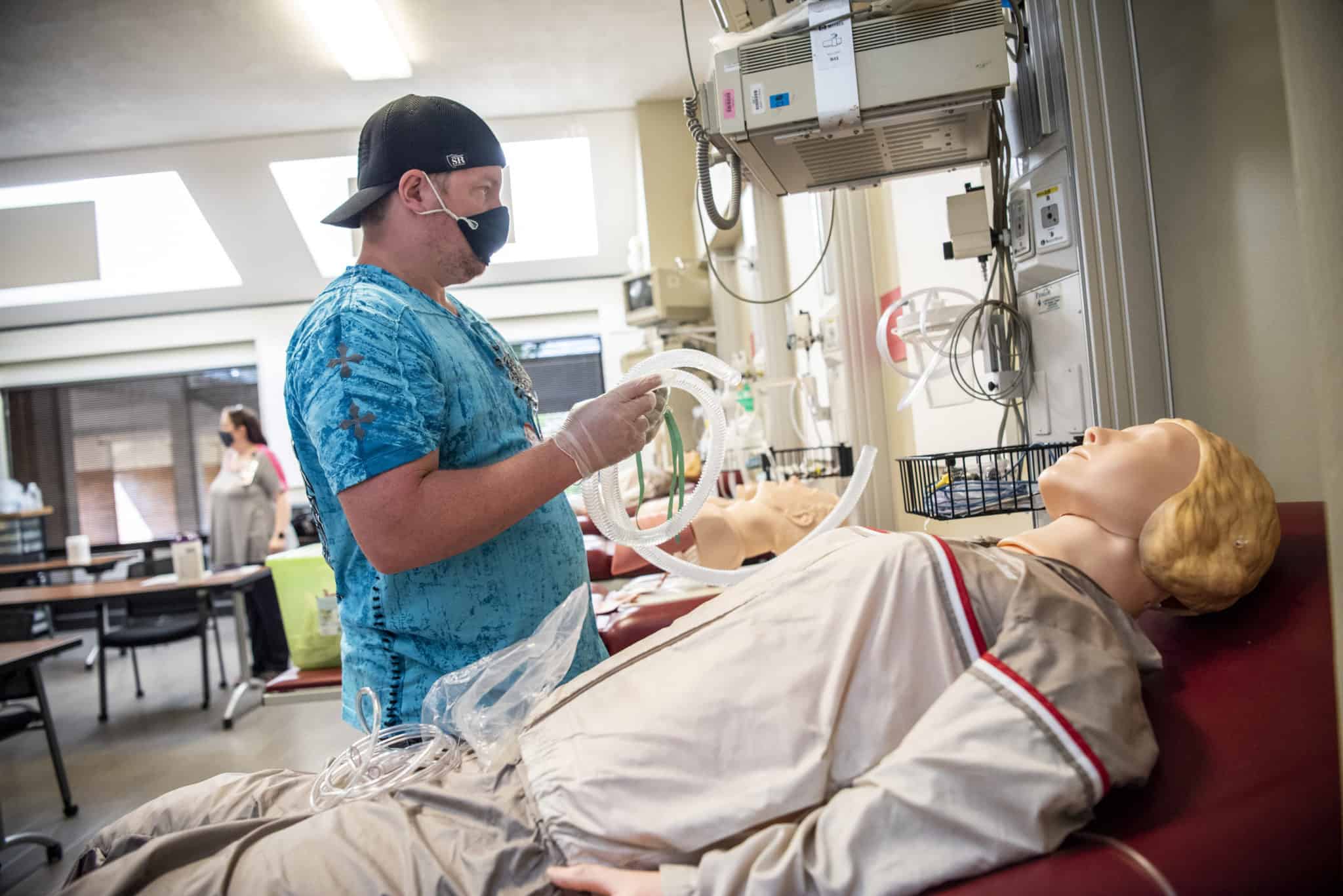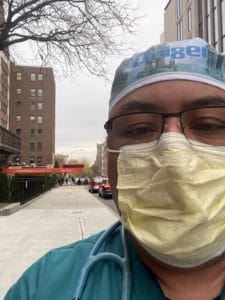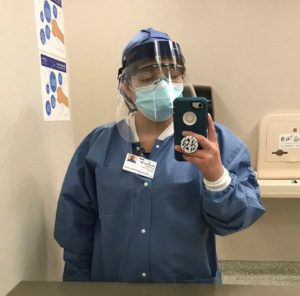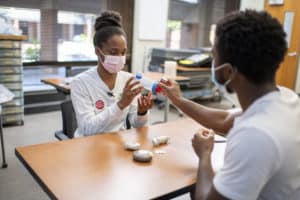View Larger Image

Respiratory Care student John Smith practices setting up an air entrainment mask.
Image by Bryan Clifton
Harder to Breathe — Respiratory Therapists ‘Last Line of Defense’ in Battle against COVID-19
| Since the emergence of COVID-19, respiratory therapists have found themselves at the forefront of the fight against the deadly virus. As the number of infected climb, these allied health professionals employ every tool at their disposal to keep their sick patients breathing.

Henry Campbell-Gomez, R.R.T., was one of the UAMS respiratory therapists who traveled to New York City in April to help with COVID-19 patients.
Such a task is grueling, but for respiratory therapists this is exactly what they’ve been trained to do.
“I have never been more proud to be a respiratory therapist than I am right now,” said Tom Jones, M.Ed., R.R.T., CPFT, chair of the Department of Respiratory Care in the College of Health Professions. “Because of this pandemic we’re being recognized for the work we’ve always done.
“We’re not just on the front lines of this pandemic; we’re often the last line of defense.”
In April as New York City’s hospitals struggled under the weight of the virus, a team of nurses and respiratory therapists from UAMS volunteered to help. UAMS respiratory therapists Henry Campbell-Gomez, R.R.T., and Tina Patton, R.R.T., reported to New York-Presbyterian Brooklyn Methodist Hospital. Heather Washington, R.R.T., a 2017 graduate of the Cardio-Respiratory Care program who works at Arkansas Children’s Hospital, went to Long Island Jewish Medical Center.
Campbell-Gomez, who deployed twice to Iraq with the Army Reserves, said he prepared for the trip to New York City as he would a military deployment.
He tried to imagine the worst scenarios possible so that he could work through his responses while he was still safe at home.
When he arrived, he could see the New York therapists were “shell shocked.”
“I knew then we were going into battle,” he said.
All three therapists described a situation unlike any they had ever witnessed.
“At UAMS, we are probably treating six to eight patients on a ventilator who are COVID-positive. When we arrived at NYC, there were about 126 patients on vents, all COVID-positive,” said Campbell-Gomez. “The respiratory therapists there were just exhausted. It felt good that we were able to lighten their load.”

Heather Washington, R.R.T., a 2017 graduate of the Cardio-Respiratory Care program who works at Arkansas Children’s Hospital, volunteered in April at Long Island Jewish Medical Center.
Washington said all of her patients had the virus and were intubated. “It was the most patients I have had on the ventilator since I’ve been a therapist,” she said, adding that several of the ventilators were ones she had never worked on before.
For Patton, it was a heart-warming and heartbreaking experience.
“I have never seen so many critically ill patients under one roof,” she said. “Everyone was so sick. People were dying all around us every day. My goal was to help keep my patients alive, but if death was imminent, I did not want anyone to die alone [visitors were not allowed] so I held their hand and prayed for them as long as I could.”
Washington was in New York for 25 days, while Patton and Campbell-Gomez stayed three weeks. All three therapists had to quarantine for 14 days when they returned to Arkansas.
COVID-19 also affected many things at UAMS. In March, when classes moved to online learning, programs scrambled to ensure learning continued. In the Department of Respiratory Care, Jones and his faculty worked diligently to ensure their seniors would graduate on time.
Because of a long history of using technology in the program, faculty were able to flip most of the courses to online in a few days,” said Jones.
“It was the clinical hours and labs that gave us the most heartburn,” he said. “You can’t do those virtually – person-to-person contact is necessary.”

Students Natasha Wilbon and Rick Nouketcheussi practice how to show a patient the proper way to use an inhaler.Bryan Clifton
“Seniors needed clinical hours to graduate,” he said, “so the Director of Clinical Education created a three-hour class on COVID-19 to fill the gap. Faculty also redesigned summer courses to make up clinical time for the juniors.”
“Our seniors graduated on time and didn’t miss a thing. We even had a 100% pass rate on credentialing exams,” he said. “The juniors started the fall completely caught up, thanks in no small part to our dedicated faculty, and partnerships with clinical affiliates like ACH, which was able to accommodate some students in June.”
“I’ve always said it is in the DNA of a respiratory therapist to adapt to change and be resourceful,” Jones said. “We really proved that with our COVID response.”
For the New York City volunteers, adapting meant putting aside fear to respond to the need.
“I was scared,” said Washington. “I’ve never been away from home and my family for that extended period of time or traveled that far without my husband. My friends and family called or texted me every day I was up there which helped.”

UAMS respiratory therapist Tina Patton on the roof of New York-Presbyterian Brooklyn Methodist Hospital.
Campbell-Gomez said he FaceTimed with his wife every evening to help process the day, adding that seeing her face eased the anxiety they both felt.
“In the end, I trusted in the training I’ve had and the equipment I was given,” he said. “I went because I believed I could do a good job.”
Patton said she “was very scared but felt called by a higher power to go.” Her family – her 12-year-old daughter and 72-year-old parents — supported her in her decision.
All three therapists would volunteer again.
“I cannot express the amount of pride I have for UAMS for sending a team to another institution in need,” said Patton. “I am proud to be a respiratory therapist at UAMS because we do great things here in Arkansas and abroad.”